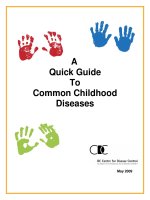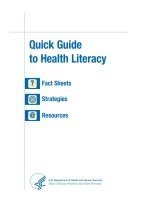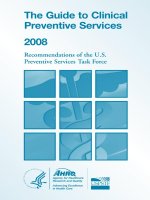Schaum''''s Quick Guide to Writing Great Research Papers - part 5 pot
Bạn đang xem bản rút gọn của tài liệu. Xem và tải ngay bản đầy đủ của tài liệu tại đây (91.26 KB, 19 trang )
Example:
Linking "national parks" with "pollution" tells the computer to
list only works with either term.
Not Using "not" narrows a search.
Example:
Telling the search engine t o look for "national parks not Bryce
Canyon" leads t o all sources about national parks except those
mentioning Bryce Canyon.
Relax!
No one is a n expert o n every facet o f the Internet-it's sim-
ply impossible. While many people are skilled with the tools
and have a good idea where to look for information on many
topics, n o one can keep up with the information flow.
Fortunately, you don't have to understand everything to use
the Internet quickly and easily. All you need are a computer,
modem, and the time to explore different paths.
This chapter helped you hop aboard the Information
Superhighway and start using electronic sources for research.
Chapter 9 shows you how to track your research.
65 Chapter 9
How Do I Track My
Research?
Research means to give each and every element
its final value by grouping it in the unity of
an organized whole.
PIERRE T. L)EC_>HARDIN
A s you start t o gather your information, you'll need a sys-
tematic way to organize it. What you want is an organized
list o f sources, a bibliography. You'll use this list to locate
sources and, as you write your research paper, to document
the information you used. In this chapter, you'll learn how
to make a working bibliography.
Making Bibliography Cards
A s you find each source o n your topic, record t h e publication
and location information. When you first start researching,
you may just print this information from electronic sources
and indexes. Later, you'll turn it into bibliography cards writ-
ten in the appropriate format.
To d o so, get a pack of 3x5 index cards. Use one card per
source. These are your bibliography cards. Cards allow you to
keep the most promising sources and discard the irrelevant
ones at your convenience. Also, cards can easily be arranged
67
in alphabetical order when the time comes to type a "Works
Cited" page for inclusion at the end of your paper.
There are several different bibliographic styles, that is,
ways of documenting sources. As you write your bibliogra-
phy cards, follow the documenting style assigned by your
instructor or preferred by the discipline in which you are
writing.
• Use the Modern Language Association (MLA) style for
research papers in the humanities, including literature,
history, the arts, and religion.
• Use the American Psychological Association (APA) style for
research papers in the social sciences, such as psychology
and sociology.
For sample MLA citations, see Chapter 17.
TRADITIONAL BIBLIOGRAPHY CARDS
What should you include on your bibliography cards?
Here are some models.
Books
On the bibliography card, note anything you are going
to need to retrieve the book. Relevant information
includes:
Call number.
Author/editor.
Title.
Place of publication.
Publisher.
Date.
Library where you found the book.
This last detail is very important, since it can save you a
great deal of time and effort if you are using more than one
library.
68
Example:
Call number,
Aafhar/adifor
PR
2981.
M7 7
Muir, Kenneth, ed. .qhakaspeare;
The Comedies. Englewood Cliffs,
New Jersey: Prentice-Hall, Inc.,
1998.
publisher
date
Location: Farmingdale Library
-Title
Place of
publication
-location
of source
Periodicals
On the bibliography card, include:
Author.
Title of the article.
Title of the periodical.
Date of the article.
Volume number.
Page numbers.
Library.
Y o u may also want t o note i f the article contained pic-
tures or illustrations that you may wish to consult.
Example:
Author
Date
Sullivan, Jack. "Weight Training
Techniques." Sport Illustrated.
31 October, 1998: 17-22
litle
Pemdieal
Page numbers
69
Electronic Sources
On your card, note:
• Medium (e.g., CD-ROM, on-line).
• Computer service.
• Date of your search.
• URL (electronic address).
Example:
On-line Web site
Contents
http:/the.tech,mit.edu/Shakespeare/
works.html
(Complete Works of Shakespeare)
America On-line
7/9/98
Date accessed Computer service
Interviews
On these cards, include:
Name of the person interviewed.
Person's area of expertise.
Person's address and telephone.
Date of the interview.
Example:
Stibjecf
Place •
Interview with Charles Lawrence,
underwater explorer and Chairperson
of Ocean Technologies 35-16 Rte 110
Lenexa, Kansas.
May 26, 1998.
617-983-0055
of
70
Date
Telephone number
Warning!
If a catalog or index does not provide complete biblio-
graphic information, leave blanks to be filled in later when
you have the actual source.
COMPUTERIZED "BIBLIOGRAPHY CARDS"
Some people prefer to make their "bibliography cards"
on a computer. This method has several advantages. First,
you can update, alphabetize, and correct your cards as you
go along. Second, at the end o f the project, you can rework
this file t o convert it to your Works Cited list o f sources.
However, be sure to back up your "cards" on floppy
disks. In addition, print out hard copies as you work. This
w a y , y o u w o n ' t lose y o u r material i f y o u r h a r d drive crashes
or the file develops a glitch.
Developing a Working Bibliography
When you start your research, your teacher may ask you to
prepare a working bibliography listing the sources you plan to
use. Your working bibliography differs from your Works
Cited page in its scope: Your working bibliography is much
larger. Your Works Cited page includes only those sources
you actually cite in your paper.
To prepare a working bibliography, arrange your bibli-
ography cards in the order required by your documentation
system ( M L A , A L A , etc.), a n d copy t h e entries o n a sheet o f
paper following the correct form.
Developing an Annotated
Bibliography
Some instructors may ask you to create an annotated bibliog-
raphy as a middle step between your working bibliography
and your Works Cited page. An annotated bibliography is
the same as a working bibliography except it includes com-
ments about the sources. These notes enable your teacher to
assess your progress.
71
Example:
You might note that some sources are difficult t o find, hard to read,
or especially useful.
This chapter explained how to make useful bibliography
cards so that you can track your research painlessly. In
Chapter 10, you'll find out how to evaluate your sources-
and why it's crucial that you do so.
72
Chapter 10
How Do I Evaluate Sources?
Nobody outside a baby carriage or a judge's chambers
believes in an unprejudiced point of view.
LILLIAN rlELLMAN
"All the news that fits we print" might be the unofficial
motto of a free press. One o f the great strengths of a free
press is its ability to print anything that does not libel its
subject. As far as researchers are concerned, however, that
very freedom presents its own problems. A source that appears
in print, in the media, or on-line is not necessarily valid. As a
result, you must carefully evaluate every source you find
before you use it. This means that you must read critically
and carefully.
As you gather your sources, evaluate them carefully.
Here are the three main criteria to use as you determine
whether a source is valid for inclusion in your research
paper:
1. Quality
2. Bias
3. Appropriateness
Let's look at each criterion in detail.
73
Quality
As Spencer Tracey said about Katharine Hepburn in the
movie Adam's Rib, "There's not much meat on her, but what
there is is choice."
The same is true for movie stars as it is for research
source materials: Quality counts. You want only the choice
cuts for your research paper. If the material isn't of the high-
est quality, it won't support your thesis, convince your read-
ers of your point, or stand up under your reader's scrutiny. In
fact, it will have just the opposite effect. That's why it's
important to evaluate the quality of every source before you
decide to include it in your research paper.
The old maxim is true: You can't judge a book by its
cover. You have to go deeper. Here's how to do it:
• Check the writer's qualifications. Is the writer or
speaker really qualified to write on the subject? Is this
someone you trust for a valid opinion? You can use the fol-
lowing simple checklist to evaluate the writer or speaker:
Is the person an expert or an eyewitness to the
events described in the source?
What is the person's reputation?
Example:
You can check in biographical source books such as
Contemporary Biography, Who's Who and Who Was W ho t o
validate a person's reputation. Anthologies often contain
biographical information about the various contributors,
too.
Does the person have the credentials to write on
this subject?
Example:
Don't be fooled by degrees.A Ph.D. in chemistry doesn't
give a scholar the credentials to write about biology,
physics, or any other subject outside his or her field.
Is the author well known and respected in the
field? How many other books or articles has the
author published on the subject?
74
Does the author have a bias or a personal agenda
to advance? Check the author's credentials and
reputation to see if you can discern bias; pay
attention to tone as well.
Evaluate the source itself. Here are some guidelines to
use:
Was the source well reviewed?
Read some critical reviews in quality journals and
newspapers to find out how the experts evaluat-
ed the book. If the book was not reviewed, it may
not be on the front line of scholarship.
Who spoke in favor of the book?
Most books have endorsements (called "blurbs")
penned by well known people in the field. These
usually appear on the back cover of the dust jack-
et. See whether the endorsements were written by
respected writers, scholars, and public figures. If
not, the book may not be a solid source. A reliable
blurb is not the final word, however; so be sure to
verify completely, as described here.
Is the publisher reputable? Is it known for pub-
lishing reliable information?
Reputable sources include scholarly journals, uni-
versity presses, and major publishers.
Is the source up-to-date? What is the publication
date?
Is the source a first edition, revision, or reprint?
While the information in first editions is usually
up-to-date, the book may be so new that it has
not yet had time to be authenticated and repli-
cated.
Is the source complete? Have certain facts been
cut for their controversial nature or for space lim-
itations? To make sure a source is complete, check
75
it i n more t h a n o n e version-especially i f it's a
crucial source.
Does the author present sufficient evidence to
support the thesis?
Does the author document his or her claims with
the titles and authors of source materials? Are
these sources credible?
Can the claims in the source be backed up in
other sources?
B e especially suspicious o f sources that claim t o
have the "secret" or "inside track." If you can't
find the same information in other sources, the
material doesn't hold up to scrutiny.
Is the source fair, or does it contain distorted
information? The following section shows you
how to evaluate sources for bias.
Bias
Every source is biased, because every source has a point of
view. Bias is not necessarily bad, as long as you recognize it
as such and take it into account as you evaluate and use the
source.
Example:
An article on hunting published in Field and Stream is likely to have a
very different slant from an article on the same subject published in
Vegetarian Times.
Problems arise when the bias isn't recognized or
acknowledged. Here are some problem areas to watch:
1. Bogus claims. A claim can be considered bogus, or false,
when the speaker promises more than he or she can
deliver.
Example:
The speaker may speak vaguely of "many important experiments"
or "recent clinical studies" to prove a point. The point may indeed
76
have value, but the studies the speaker cites as proof are too fuzzy
to have merit.
Well educated people are rightly skeptical about promises
from strangers.
Effective research sources use specific support, not just
vague references to unidentified studies and sources. You
can't evaluate "many important experiments" or "recent
clinical studies" unless you know how they were undertak-
en, by whom, and where the results were published.
Also be on the lookout for sources that refer to "statistics
that show ." Statistics can be very useful in proving a point,
but they can also be misleading-especially if you don't have
the numbers to evaluate their validity. Ask yourself:
• Do the statistics raise any unanswered questions?
• Has the source of the statistics been revealed?
"Well known" information is another form of bogus
claim. Be wary of sources that tell you that "Everybody
knows that " or "It is a well known fact that ." If the fact
is so "well known," why is the writer bothering to cite it as
support? Very likely, it's the best support the writer can
muster-which doesn't speak well for the validity of the
source or writer.
2. Loaded terms. Suspect sources may use "loaded terms"
to make their point. A term becomes loaded when it is
asked to carry more emotional weight than its context
can legitimately support. As a result, it becomes slanted or
biased. These sources are often not reliable.
Words with strong connotations (emotional responses)
often show bias.
Example:
A writer refers to the governor's "regime" rather than "administra-
tion.'' "Regime" is a loaded term because it is used to describe
oppressive military dictatorships.
While loaded terms are most often used in political writ-
ing and speech, they can appear in any source. That's why
it's important to read critically.
77
3. Misrepresentation. This type of bias takes many
forms. First, a writer or speaker can lie outright. Or a
writer may be more subtle, inventing false data or "facts."
In addition, dishonest writers often twist what their
opponents have said. To misrepresent people this way,
they use oversimplification. A complex argument can be
reduced to ridicule in a slogan, or an important element
of an argument can be skipped over.
How can you protect yourself from being misled by this
type of bias? Here are some issues to consider as you evalu-
ate a text for misrepresentation:
• Is someone quoted out of context?
• Are facts or statistics cited in a vacuum?
• Does the quotation reflect the overall content of the
source or does it merely reflect a minor detail?
• Has key information been omitted?
To verify this, be sure to check two versions of the
source. Remember, if something looks too good to be true, it
probably is!
Appropriateness
Even if a source passes the first two tests and proves to be of
high quality and free from bias, it may still not belong in
your research paper. For a source to make the final cut, it has
to fit with your audience, purpose, and tone. It must be
appropriate to your paper. How can you decide if a source is
suitable for inclusion in your research paper? Try these sug-
gestions:
• Do you understand the material in the source?
• If the source is too technical for you to grasp fully, you
might not use it correctly in your paper.
• Is the source written at a level appropriate to your readers?
• Does this source have the information you need?
• Does the source suit your purposes in this research paper?
78
A Special Note on Evaluating
Electronic Sources
Be especially leery of electronic sources that you'll find on
the Internet. They can be difficult to authenticate and vali-
date. Unlike most print resources such as magazines and
journals that go through a filtering process (e.g., editing,
peer review), information on the Web is mostly unfiltered.
What does this mean for you? Using and citing information
found over the Web is a little like swimming on a beach
without a lifeguard.
PORTABLEVS. ON-LINE SOURCES
As a result, you have to use electronic sources with
special care. To evaluate electronic sources, first see if the
source is portable or on-line.
• Portable sources, such as CD-ROMs and encyclopedias, are
like printed books: They have credited writers and pub-
lishers. In addition, they change only when a new ver-
sion is issued. As a result, you can determine their value
as you would a book.
• On-line sources, in contrast, may be published anony-
mously. This means you can't evaluate the writer or writ-
ers. Also, they can be updated and revised without noti-
fication. Further, they may vanish without warning. This
makes it difficult to evaluate their reliability.
HEADER, BODY, AND FOOTER
Once you've determined that you are dealing with an
on-line source, check the Web document for its three main
elements: head, body and footer. Within each of these
pieces, you should be able to determine the following vital
elements for evaluating information:
1. Author or contact person (usually located in the
footer)
As you evaluate the selection, ask yourself:
• Who is the author of the piece?
79
• Is the author the original creator o the information?
• Does the author list his or her occupation, years of
experience, position, or education?
• With this information or lack o it, do you feel this per-
son is qualified to write on the given topic?
• Where does the on-line source come from? Knowing
the source of the site can help you evaluate its purpose
and potential bias.
Example:
A business has a different slant from a university. It's likely that the
business wants to sell you a product or a service, while the univer-
sity s probably seeking to disseminate knowledge.
You can often find clues to the origin o an on-line source
in its address (URL, or Uniform Resource Locator). Look
for the suffix to identify the source. Here are the com-
mon URL suffixes you'll encounter:
Suffix Meaning
com
Commercial (business or company)
edu Education (academic site)
gov Government
int International organization
mil Military organization
net Internet administration
org Other organizations, including nonprofit,
nonacademic, and nongovernmental groups
sci Special knowledge news group
2. Link to local home page (usually located either in
header or footer) and institution (usually located in either
header or footer). A s you evaluate the selection, ask your-
self
• What institution (company, government, university,
etc.) or Internet provider supports this information?
80
• If it is a commercial Internet provider, does the author
appear to have any affiliation with a larger institution?
• If it is an institution, is it a national institution?
• Does the institution appear to filter the information
appearing under its name?
• Does the author's affiliation with this particular insti-
tution appear to bias the information?
3. Date of creation or revision (usually located in foot-
er).
• When was the information created or last updated?
4. Intended audience (determined by examining the
body).
5. Purpose of the information, i.e., does it inform,
explain, or persuade (determined by examining the
body)?
Given all the information you determined from these
clues, is this piece of information appropriate for your topic?
If yes, explain your decision and express any reservations as
you would with any other information.
In summary, all sources are not equally valid. Be sure to
carefully and completely evaluate every source you find
before you decide whether to use it in your research paper.
Weak or inaccurate sources can seriously damage your credi-
bility as a writer and thinker.
Now that you've made sure your sources are solid, it's
time to learn how to document them. It's all covered in the
next chapter.
81
How Do I Document My
Sources?
One of the skills of research is knowing when you have
enough information; in considering too many side
issues or too many perspectives, you may lose the
main thread of your subject.
CHARLES BAZERMAN
Use sources to help you advance the thesis you have defined.
The sources back up your point and help you make new con-
nections among ideas. No matter how many sources you use,
their purpose remains the same: to help you make the points
you want to make. That's what this chapter is all about.
Reading for Research
Now that you've gathered all your sources (or the vast major-
ity of them), it's time to take notes o n the relevant material.
"Relevant" is the key word. How can you tell what you need
for your paper and what should end up in the scrap heap?
In most cases you can't tell what's going to make the cut
a n d w h a t won't. A s a result, you usually take far more notes
than you need. Don't worry: Nearly all researchers wind up
with extra notes. The deeper you dig into your subject, how-
ever, the more perceptive you become about what you need
83









